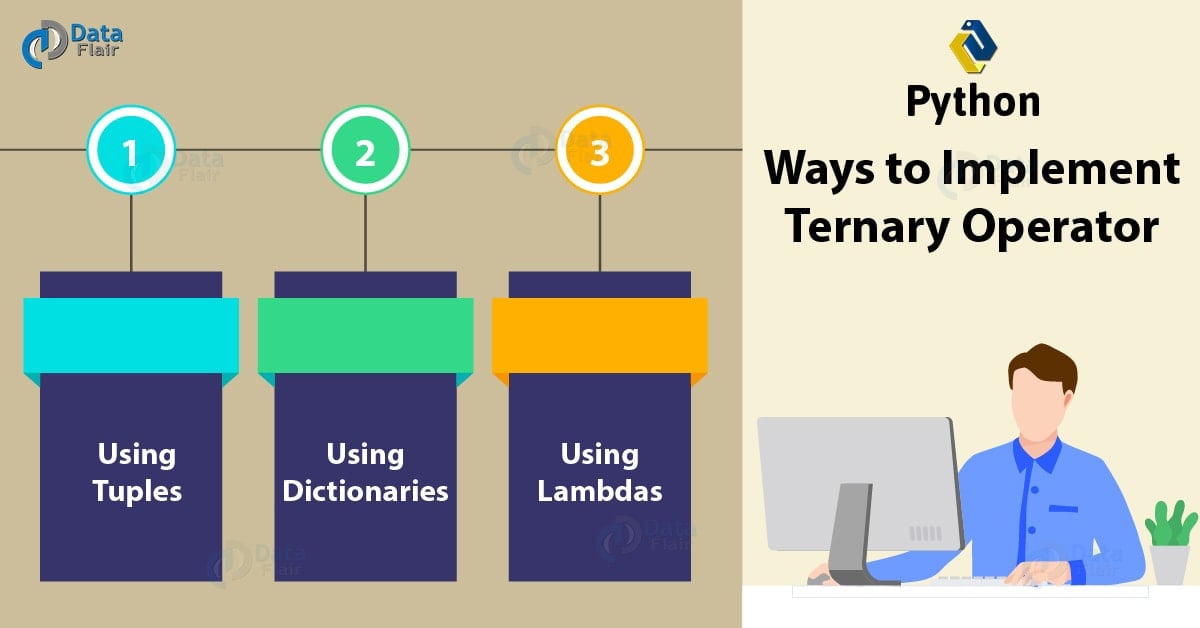Python Ternary Operator – 5 Ways To Implement Ternary Operators
Python course with 57 real-time projects - Learn Python
Today, we will see Python Ternary Operator. Moreover, we will discuss the example and syntax of Ternary Operator in Python.
Also, we will learn before and nested Python Ternary Operators. At last, we will discuss ways for implementing Ternary operators in Python.
So, let’s start Python Ternary Operator.
What is Python Ternary Operator?
Ternary operators in Python are terse conditional expressions. These are operators that test a condition and based on that, evaluate a value.
This was made available since PEP 308 was approved and is available ever since version 2.4. This operator, if used properly, can reduce code size and enhance readability.
1. Python if-else code
Let’s write code to compare two integers.
>>> a,b=2,3
>>> if a>b:
print("a")
else:
print("b")Output
2. Equivalent code with Ternary operator
So let’s try doing the same with ternary operators:
>>> a,b=2,3
>>> print("a" if a>b else "b")Output
Voila! Done in one line. Python first evaluates the condition. If true, it evaluates the first expression; otherwise, it evaluates the second.
There is a lazy evaluation. It also evaluates the conditions left to right.
The syntax for Python Ternary Operator
Now, let’s learn a little the syntax for Python Ternary Operator.
[on_true] if [expression] else [on_false]
In C++, it looks like this:
max=(a>b)?a:b
But this isn’t quite Pythonic, so Guido, Python’s BDFL (a status from which he has resigned permanently), rejected it.
Another reason for the veto is that we already have many uses for the colon(:).
One more example of Python ternary Operators:
>>> from random import random >>> a,b=random(),random() >>> res="a" if a>b else "b" >>> res
Output
>>> a,b
Output
Ways to Implement Ternary Operator
Below, we are discussing different ways of implementing Python Ternary Operator:
1. Using Python Tuples
We can use tuples to specify what to do if the condition is True/False.
>>> a,b=random(),random() >>> (b,a)[a>b]
Output
This is equivalent to:
>>> (b,a)[True]
But we’re confused which this is- a or b. Let’s try tweaking this.
>>> (f"b:{b}",f"a:{a}")[a>b]Output
That’s more like it. Looking at the code, you’ll reckon the first argument in the tuple corresponds to a Boolean value of False; the second- True. This is because of False=0 and True=1. The condition resides within the [ ].
Note that this method evaluates both elements of the tuple, and hence is less efficient. This happens because it must first build the tuple before it can look for an index.
>>> condition=True >>> 2 if condition else 1/0 #Follows the normal if-else logic tree
Output
>>> (1/0,2)[condition]
Output
File “<pyshell#48>”, line 1, in <module>
(1/0,2)[condition]
ZeroDivisionError: division by zero
2. Using Python Dictionaries
Likewise, we can make this happen using dictionaries with the same logic.
>>> a,b=random(),random()
>>> {False:f"b:{b}",True:f"a:{a}"}[a>b]Output
Since we specify what to do when here, we can interchange the positions of key-value pairs.
>>> {True:f"a:{a}",False:f"b:{b}"}[a>b]Output
3. Using Lambdas
We can also make use of Python Lambda Functions to act as a ternary operator.
>>> (lambda :f"b:{b}",lambda :f"a:{a}")[a>b]()Output
Nested Python Ternary Operator
Let’s try chaining these operators, shall we?
>>> a=random() >>> "Less than zero" if a<0 else "Between 0 and 1" if a>=0 and a<=1 else "Greater than one"
Output
>>> a
Output
Here, we check for the value of a. If it falls shorter than 0, we print “Less than zero”; if between 0 and 1, we print “Between 0 and 1”. Else, we print “Greater than one”. Notice how we nested them.
Before Ternary Operators in Python
Before this was a thing with Python, this is what we did (we used a common idiom):
>>> a,b=2,3 >>> a<b and a or b
Output
So how does this work? Let’s see.
- a is 2 and b is 3
- It checks if a<b
- If true, it gives us True and a or b
- This gives us a or b
- It checks a
- If false, it gives us False or b
- This gives us b
This method, however, doesn’t work for a=0. This is because that would be True and 0 or b, which is True and False or b, which is False or b, which is b. Oops!
Now why don’t you try formulating an expression for a>b and try explaining it to yourself?
It could also be beneficial to use the and/or logic when one of our expressions is the same as the condition:
>>> def sayhello(): print('Hello')
>>> sayhello() if sayhello() else 'Bye'Output
Hello
True
>>> sayhello() or 'Bye'
Output
True
So, this was all in Python Ternary Operator. Hope you like our explanation.
Python Interview Questions on Ternary Operator
- Does Python have a Ternary operator?
- How do you use a Python Ternary operator?
- Explain Python ternary operator with example?
- What is Python ternary operator symbol?
- Are Python ternary operators readable?
Conclusion
Phew! That’s all. Through this Python Ternary Operator blog, we tried our best to bring to you all there is to know about the ternary operator in Python. Moreover, we discussed the implementation of Ternary Operators in Python.
Also, we saw Python Ternary Operators example and syntax. We curated our content from the best sources. Like this tutorial?
If you’d like us to write about something that has to do with Python (and we haven’t already), please let us know in the comments below. We are excited to hear from you!
If you are Happy with DataFlair, do not forget to make us happy with your positive feedback on Google




Great tutorials so far been studying at my own space and also a great reference blog.
Thanks
Thanks for liking the Python Ternary Operator Tutorial. Do enroll in DataFlair Free Python Course to learn more.
I think there is a typo, or correct me if I’m wrong:
In section 6:
<>
The last two lines in the explanation seem incorrect:
Given explanation:
a is 2 and b is 3
It checks if a<b
If true, it gives us True and a or b
This gives us a or b
It checks a
If false, it gives us False or b
This gives us b
However, The statement 'It checks a' should follow:
If true, it gives us True or b
This gives us a
Since 2 is output.
I actually read it as
if a < b is True
return a
else return b
much like
a if a<b else b
No in that case it will always be true because “true or anything” is true. That’s why it is explained with the false example.
>>> def sayhello(): print(‘Hello’)
>>> sayhello() if sayhello() else ‘Bye’
The above statement printing “bye” cause sayhello() function doesn’t return anything i.e None so, the if takes 0(zero) as condition and goes for the else thus,printing “Bye”.
Hey, the given code prints “Hello”. We would recommend you to rerun the code.
I also got same answer.
Please explain , how you got Hello and True.
I also got same answer.
Please explain , how you got Hello and True.